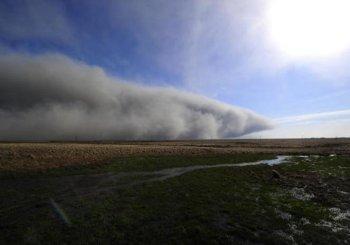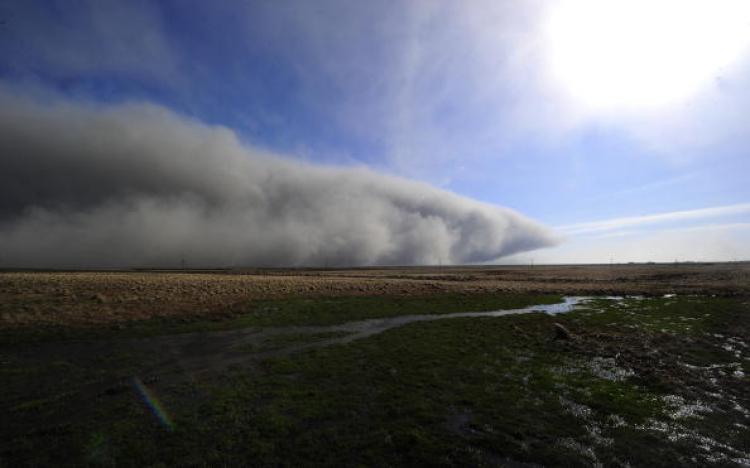LONDON—A new plume of ash from the Eyjafjallajokull volcano is moving toward the United Kingdom and has increased the likelihood of the cloud affecting U.S. airspace.
“The volcano eruption in Iceland has strengthened and a new ash cloud is spreading south and east toward the U.K.,” said Britain’s National Air Traffic Services (NATS) on Monday.
The previous plume of ash from the Icelandic volcano that grounded tens of thousands of flights in Europe, is expected to hit North America on Tuesday.
The U.K.’s National Weather Service indicated on Monday that the ash cloud could spread further south into New York airspace early this week, but forecasters believe that the low concentration of ash posed little threat to aviation.
“The ash in the atmosphere now is mostly from the first eruption last week, and it has spread out over thousands of kilometers and diffused,” said Jim Andrews, senior meteorologist for AccuWeather.com, a forecaster connected to State College, Pennsylvania.
“The concentration of the ash is therefore very low, even below critical levels for aviation,” he said in an interview.
However, he said that the situation could change for North America, particularly next week if there was another major eruption.
The prospect of ash affecting flights in eastern Canada prompted a handful of early cancellations on Sunday night. Flights resumed the following morning in Newfoundland and Labrador.
The new plume of ash may have increased the likelihood of effecting North American airspace.
Andrews said that if there was another eruption before Thursday this week, it would be Britain and most of Northern Europe that would bear the brunt of it.
If the eruption took place after Thursday, he said, the changing wind pressures meant that the situation for North America would be “more complicated.”
“If we get a more substantial eruption, there’s a chance it could reach the northeastern part of North America. However, this is purely speculation, given how unpredictable the volcano has proved to be.”
Since the Eyjafjallajokull volcano erupted on April 14, as many as 81,000 flights have been canceled in Europe, leaving hundreds of thousands of passengers stranded.
Airlines have protested against government-imposed flying bans saying it has cost the industry $200 miilion-$270 million a day. British Airways said it had flown a plane Sunday through the no-fly zone and found “no variations in the aircraft’s normal operational performance.”
Parts of Europe were expected to open to flights on Tuesday morning, after transport ministers divided the region’s airspace into areas where it was and was not safe to fly.
However, industry figures were critical of the official response to the crisis, with the International Air Transport Association saying there had been little risk assessment and “no leadership.”
“It’s embarrassing, and a European mess,” said Giovanni Bisignani, chief executive of IATA.
Despite that, an unnamed diplomat quoted by AP said that several NATO F-16 fighters had accumulated glass-like deposits in the engines after flying through the ash cloud, suggesting that the threat to airlines and passengers is real.
Several forecasters in Europe and Canada noted that the volcano has emitted little ash since the major eruption last week, prompting speculation that the worst is already over.
Others have noted that the last time Eyjafjallajokull erupted was in 1821 and it lasted for 13 months.
“The volcano eruption in Iceland has strengthened and a new ash cloud is spreading south and east toward the U.K.,” said Britain’s National Air Traffic Services (NATS) on Monday.
The previous plume of ash from the Icelandic volcano that grounded tens of thousands of flights in Europe, is expected to hit North America on Tuesday.
The U.K.’s National Weather Service indicated on Monday that the ash cloud could spread further south into New York airspace early this week, but forecasters believe that the low concentration of ash posed little threat to aviation.
“The ash in the atmosphere now is mostly from the first eruption last week, and it has spread out over thousands of kilometers and diffused,” said Jim Andrews, senior meteorologist for AccuWeather.com, a forecaster connected to State College, Pennsylvania.
“The concentration of the ash is therefore very low, even below critical levels for aviation,” he said in an interview.
However, he said that the situation could change for North America, particularly next week if there was another major eruption.
The prospect of ash affecting flights in eastern Canada prompted a handful of early cancellations on Sunday night. Flights resumed the following morning in Newfoundland and Labrador.
The new plume of ash may have increased the likelihood of effecting North American airspace.
Andrews said that if there was another eruption before Thursday this week, it would be Britain and most of Northern Europe that would bear the brunt of it.
If the eruption took place after Thursday, he said, the changing wind pressures meant that the situation for North America would be “more complicated.”
“If we get a more substantial eruption, there’s a chance it could reach the northeastern part of North America. However, this is purely speculation, given how unpredictable the volcano has proved to be.”
Since the Eyjafjallajokull volcano erupted on April 14, as many as 81,000 flights have been canceled in Europe, leaving hundreds of thousands of passengers stranded.
Airlines have protested against government-imposed flying bans saying it has cost the industry $200 miilion-$270 million a day. British Airways said it had flown a plane Sunday through the no-fly zone and found “no variations in the aircraft’s normal operational performance.”
Parts of Europe were expected to open to flights on Tuesday morning, after transport ministers divided the region’s airspace into areas where it was and was not safe to fly.
However, industry figures were critical of the official response to the crisis, with the International Air Transport Association saying there had been little risk assessment and “no leadership.”
“It’s embarrassing, and a European mess,” said Giovanni Bisignani, chief executive of IATA.
Despite that, an unnamed diplomat quoted by AP said that several NATO F-16 fighters had accumulated glass-like deposits in the engines after flying through the ash cloud, suggesting that the threat to airlines and passengers is real.
Several forecasters in Europe and Canada noted that the volcano has emitted little ash since the major eruption last week, prompting speculation that the worst is already over.
Others have noted that the last time Eyjafjallajokull erupted was in 1821 and it lasted for 13 months.






